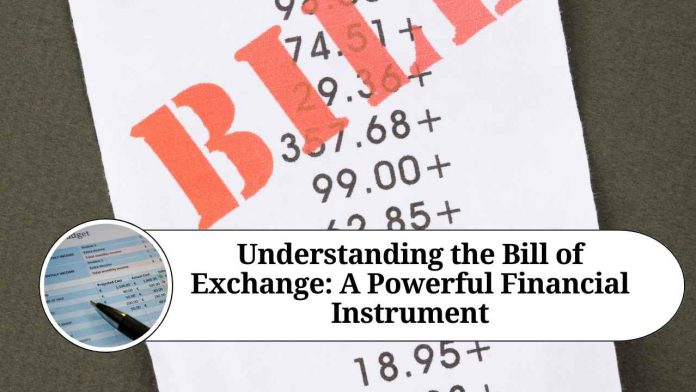In the world of business and commerce, various financial instruments are used to facilitate transactions and ensure smooth operations. One such instrument that has been widely used for centuries is the Bill of Exchange. This document holds immense importance in international trade and serves as a reliable method of payment and credit assurance. In this blog, we will delve into the concept of the Bill of Exchange, its features, benefits, and its role in modern-day transactions.
What is a Bill of Exchange?
A Bill of Exchange is a legally binding document that serves as a written order issued by one party, known as the drawer, to another party, known as the drawee, instructing the drawee to pay a specific amount of money to a third party, known as the payee, on a predetermined future date or upon presentation of the bill. It is essentially a promise to pay, guaranteeing the recipient the payment of a specified sum of money.
Key Features of a Bill of Exchange:
- Parties involved: The Bill of Exchange involves three key parties – the drawer, who issues the bill; the drawee, who is ordered to make the payment; and the payee, who is entitled to receive the payment.
- Unconditional payment: The payment promised in a Bill of Exchange is usually unconditional, meaning that the drawee is obligated to pay the specified amount to the payee upon maturity or presentation of the bill, regardless of any circumstances or disputes between the parties.
- Negotiable instrument: The Bill of Exchange is a negotiable instrument, which means it can be transferred from one party to another by endorsement or delivery. This feature enables the bill to be used as a form of payment, a credit instrument, or a means of raising funds.
- Time element: A Bill of Exchange includes a specified maturity date, on which the payment becomes due. The maturity date provides clarity and ensures that both parties are aware of the payment obligations and timelines.
Benefits of a Bill of Exchange:
- Facilitates international trade: The Bill of Exchange has long been used in international trade as a secure method of payment. It enables businesses to engage in cross-border transactions, reducing the risk of non-payment or delayed payment.
- Credit assurance: The Bill of Exchange offers credit assurance to the payee. Since the payment is guaranteed by the drawee, it provides an additional layer of trust and security for businesses engaging in transactions.
- Cash flow management: For businesses, the Bill of Exchange helps in managing cash flow effectively. By issuing a bill with a deferred payment date, the drawer can extend payment terms while ensuring the payee receives the payment at a later date.
- Financing tool: Bill of Exchange can also serve as a financing tool. The payee, who may need immediate funds, can discount or sell the bill to a bank or financial institution at a discounted value, thereby obtaining funds before the maturity date.
Conclusion:
The Bill of Exchange is a powerful financial instrument that has played a crucial role in facilitating trade and commerce throughout history. Its ability to provide credit assurance, enable international transactions, and aid in cash flow management makes it an invaluable tool for businesses worldwide. While modern payment methods have gained popularity, the Bill of Exchange continues to hold relevance in certain sectors and international trade scenarios. Understanding its features and benefits can empower businesses to make informed decisions and leverage this instrument effectively in their operations.
Other Related Blogs: Section 144B Income Tax Act
Frequently Ask Question
Q. What is a Bill of Exchange?
A Bill of Exchange is a written document issued by one party, known as the drawer, to another party, known as the drawee, instructing the drawee to pay a specified amount of money to a third party, known as the payee, at a predetermined future date or upon presentation of the bill.
Q. What are the key parties involved in a Bill of Exchange?
The key parties involved are the drawer, who issues the bill; the drawee, who is ordered to make the payment; and the payee, who is entitled to receive the payment.
Q. How does a Bill of Exchange work?
The drawer creates a bill, specifying the amount, the maturity date, and the payee. The drawee accepts the bill and becomes legally obligated to pay the specified amount to the payee upon maturity or presentation of the bill. The payee can then present the bill for payment and receive the funds from the drawee.
Q. Is a Bill of Exchange a negotiable instrument?
Yes, a Bill of Exchange is a negotiable instrument, which means it can be transferred from one party to another by endorsement or delivery. This feature allows it to be used as a form of payment, credit instrument, or means of raising funds.
Q. What is the purpose of a Bill of Exchange?
The Bill of Exchange serves as a method of payment, credit assurance, and financing tool. It facilitates trade, especially in international transactions, by providing security and trust between the parties involved.
Q. What are the advantages of using a Bill of Exchange?
Using a Bill of Exchange provides credit assurance, enables businesses to manage cash flow effectively, and facilitates international trade. It also allows for financing options through bill discounting.
Q. Can a Bill of Exchange be dishonored?
Yes, a Bill of Exchange can be dishonored if the drawee fails to make the payment as promised. The payee has legal remedies available to recover the amount, such as legal action or pursuing the drawer for payment.
Q. Are there different types of Bills of Exchange?
Yes, there are different types of Bills of Exchange, including sight bills (payable upon presentation) and term bills (payable on a future date). There are also documentary bills, which require the presentation of specific documents to receive payment.
Q. Is a Bill of Exchange still relevant in today’s digital age?
While electronic payment methods have gained popularity, the Bill of Exchange remains relevant, particularly in certain sectors and international trade scenarios. It offers unique advantages and serves as a trusted financial instrument.
Q. Are there any legal requirements for a Bill of Exchange?
Yes, a Bill of Exchange must comply with certain legal requirements, such as being in writing, containing an unconditional promise to pay, and specifying the parties involved and the amount to be paid. These requirements may vary depending on the jurisdiction.




















